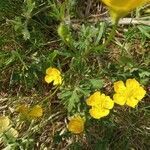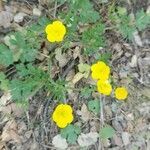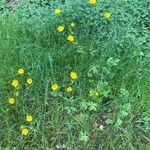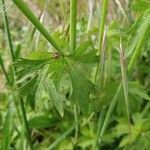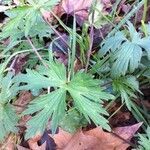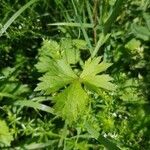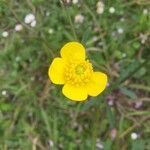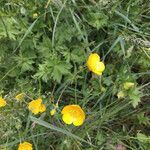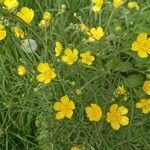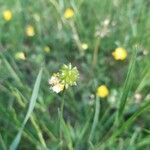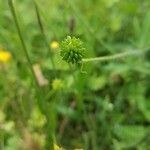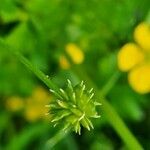Stems erect from short caudex or rhizome, never rooting nodally, hispid, strigose, or glabrous, base not bulbous. Roots never tuberous. Basal leaf blades pentagonal in outline, deeply 3-5-parted, 1.8-5.2 × 2.7-9.8 cm, segments 1-2×-lobed or-parted, ultimate segments narrowly elliptic or oblong to lanceolate, margins toothed or lobulate, apex acute to rounded. Flowers: receptacle glabrous; sepals spreading, 4-6(-9) × 2-5 mm, hispid; petals 5, yellow, 8-11(-17) × 7-13 mm. Heads of achenes globose, 5-7(-10) mm wide; achenes 2-3 × 1.8-2.4 mm, glabrous, margin forming narrow rib 0.1-0.2 mm wide; beak persistent, deltate, usually with tip short or long, straight or curved, subulate, 0.2-1 mm. 2 n = 14.
Spreading-hairy perennial, slender, eventually to 1 m, leafy mostly below the middle, the long branches with few, widely separated, much reduced lvs; lvs reniform, deeply 3-cleft, the broadly cuneate-obovate segments incised or cleft into oblong or linear lobes; pet broadly obovate, often retuse, 8–16 mm, twice as long as the sep; achenes in a subglobose head, flat, margined, broadly and obliquely obovate, 2–3 mm, the beak 0.4–1 mm; 2n=14, 28, 29, 32. Native of Europe, widely introduced in N. Amer. as a weed in fields and meadows and along roadsides. May–Sept. Double-flowered forms occur.
A plant which keeps growing from year to year. It grows 60-100 cm high and spreads 60-120 cm wide. The leaves have teeth and 3-7 lobes. The flowers are yellow and in small clusters. They are 25 mm wide.
Description pending.
